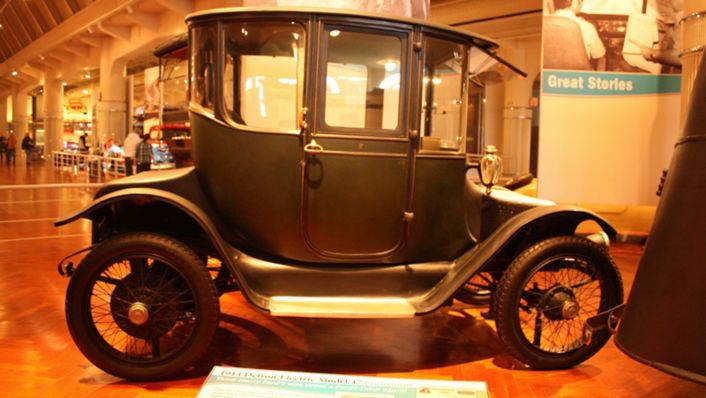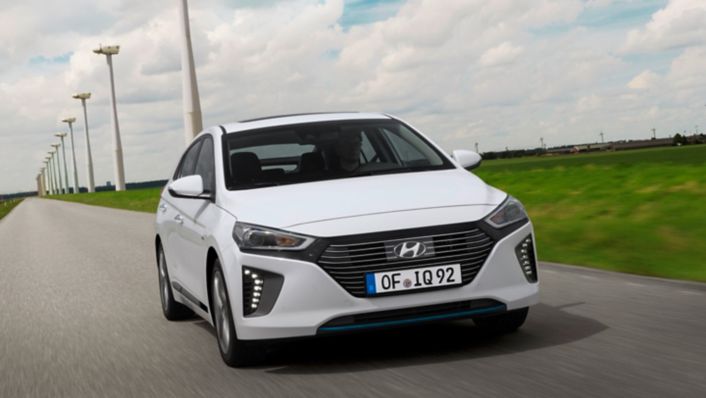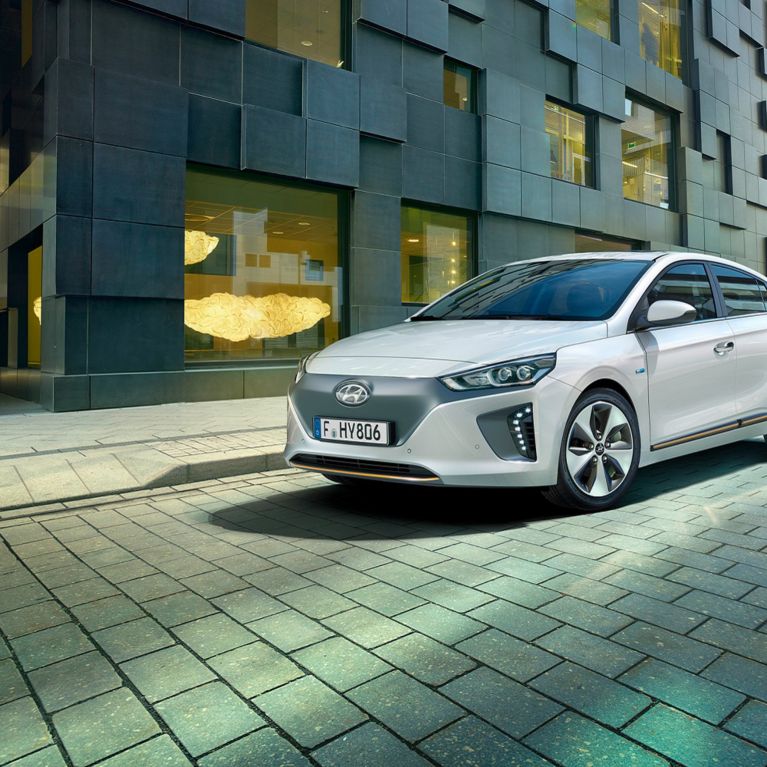Although electric cars and hybrids have only started to become widely used in the last decade, the history of eco-friendly vehicles actually dates right back to the invention of the automobile itself.
Early electric vehicles
Some of the first cars were electric as designers experimented with a variety of different power sources, though admittedly they were more concerned with developing a working car than any particular environmental benefits.
Electric vehicles first appeared in the mid-19th century, back when people wore high hats and streets were mainly lit by gas lamps. The first known electric car was powered by galvanic cells (i.e. batteries). It was built in 1837 by Robert Davidson, a lifelong resident Aberdeen in northeast Scotland. Davidson was a chemist by trade, having been educated at Marischal College between 1819-1821. In the 1820s he set up a yeast-supplying business close to the Aberdeen-Inverurie Canal, before becoming involved in the manufacture and supply of chemicals. Taking a keen interest in the new electrical technologies of the day, he produced his first small electric motor independently of William H. Taylor from the US, who made similar motors from 1838.

Due to the high cost, low top speed and short battery life, however, there was a worldwide decline in their use; although electric vehicles have continued to be used in the form of electric trains and trams. In the early twentieth century it became clear that cars powered by internal combustion engines would win out and almost all cars for the next ninety years were built with them.
Another early technology used in the early development of cars was hybrid power. Most people think of this as being a modern invention, but it was actually developed by Ferdinand Porsche as far back as 1900, with his Lohner-Porsche Mixte Hybrid. The early 1900s saw the dawn of modern technologies such as Thomas Edison's alkaline storage battery, which proved useful for lighting railway cars and signals, as well as widespread application of the internal combustion engine, which led to mass production of the automobile. For the next thirty years several engineers developed cars using hybrid engines, but with petrol cheap and readily available consumers saw no reason to change, and hybrids didn’t manage to take off.
There were a few eco-friendly car revivals over the following decades. Following World War II there was a brief upsurge in the popularity of eco-friendly cars in Europe and Japan as car buyers sought smaller fuel -efficient vehicles due to global fuel shortages. However this was not to last. Interest in eco-friendly cars began to re-emerge in the 1970s as car manufacturers began to explore the potential of hybrid technology, but towards the end of the decade the price of petrol plummeted and no hybrids were actually built.
Another early technology used in the early development of cars was hybrid power. Most people think of this as being a modern invention, but it was actually developed by Ferdinand Porsche as far back as 1900, with his Lohner-Porsche Mixte Hybrid. The early 1900s saw the dawn of modern technologies such as Thomas Edison's alkaline storage battery, which proved useful for lighting railway cars and signals, as well as widespread application of the internal combustion engine, which led to mass production of the automobile. For the next thirty years several engineers developed cars using hybrid engines, but with petrol cheap and readily available consumers saw no reason to change, and hybrids didn’t manage to take off.
Environmental concerns convince car makers to seek an alternative to petrol
There were a few eco-friendly car revivals over the following decades. Following World War II there was a brief upsurge in the popularity of eco-friendly cars in Europe and Japan as car buyers sought smaller fuel -efficient vehicles due to global fuel shortages. However this was not to last. Interest in eco-friendly cars began to re-emerge in the 1970s as car manufacturers began to explore the potential of hybrid technology, but towards the end of the decade the price of petrol plummeted and no hybrids were actually built.

With fuel consumption having a huge impact on the quality of air in big cities, environmental concerns had entered the mainstream by the mid-1990s. This prompted car makers to begin mass-producing hybrid vehicles. The first successful mass-produced hybrid car boasted a game-changing gas-electric engine. This entered the Japanese market in 1997 before being introduced globally in 2000, and made the automotive world realise that environmentally-friendly cars were here to stay.
Many global brands were quick to jump on the hybrid bandwagon by launched their own models. At the 2009 Seoul Motor Show Hyundai unveiled the Elantra LPI Hybrid – the LPI stands for “Liquefied Petroleum Injected” – which became the world’s first hybrid vehicle to be powered by an internal combustion engine built to run on liquefied petroleum gas as a fuel. The LPI Hybrid was the first to adopt lithium-ion polymer batteries, which Hyundai developed together with its local partners. These differed from traditional lithium-ion batteries, using a more stable and fire-resistant dry polymer electrolyte instead of a liquid or gel.
Over the past decade Hyundai has established itself as a leader in clean technology with a number of innovations, including the world's first mass-produced hydrogen-powered vehicle with the ix35 Fuel Cell. The company’s latest model, the Hyundai IONIQ, is the world's first car with three electric power trains, and comes in three environmentally-friendly options: electric, pug-in hybrid and hybrid that use Blue Drive® technology to emit lower levels of pollution and provide higher performance. Each IONIQ has been designed with aluminium and advanced high-strength steel, so it uses less energy as it moves down the road.
Environmentally-friendly vehicles were not always the goal when it came to electric cars, as they are now. Early technologies failed because they were not deemed to be flexible enough to justify the high costs of their design and production. However, now the technology is more affordable, car manufacturers are able to produce an increasing number of eco-friendly models each year. The future of the industry certainly looks green.
Hyundai embraces hybrids
Many global brands were quick to jump on the hybrid bandwagon by launched their own models. At the 2009 Seoul Motor Show Hyundai unveiled the Elantra LPI Hybrid – the LPI stands for “Liquefied Petroleum Injected” – which became the world’s first hybrid vehicle to be powered by an internal combustion engine built to run on liquefied petroleum gas as a fuel. The LPI Hybrid was the first to adopt lithium-ion polymer batteries, which Hyundai developed together with its local partners. These differed from traditional lithium-ion batteries, using a more stable and fire-resistant dry polymer electrolyte instead of a liquid or gel.
Over the past decade Hyundai has established itself as a leader in clean technology with a number of innovations, including the world's first mass-produced hydrogen-powered vehicle with the ix35 Fuel Cell. The company’s latest model, the Hyundai IONIQ, is the world's first car with three electric power trains, and comes in three environmentally-friendly options: electric, pug-in hybrid and hybrid that use Blue Drive® technology to emit lower levels of pollution and provide higher performance. Each IONIQ has been designed with aluminium and advanced high-strength steel, so it uses less energy as it moves down the road.
Environmentally-friendly vehicles were not always the goal when it came to electric cars, as they are now. Early technologies failed because they were not deemed to be flexible enough to justify the high costs of their design and production. However, now the technology is more affordable, car manufacturers are able to produce an increasing number of eco-friendly models each year. The future of the industry certainly looks green.










